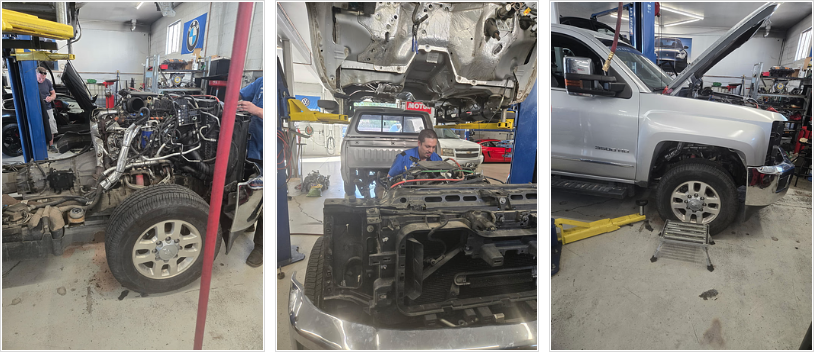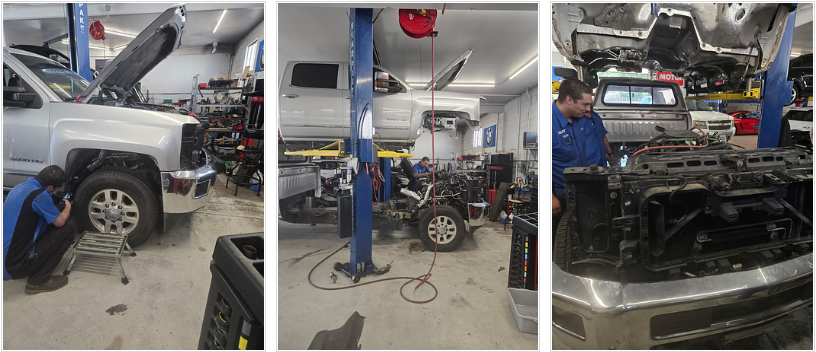From the Shop: Case Study of a 2015 Chevy Silverado 3500 “Limp Mode” Mystery

Losing power in your truck is a frustrating and often scary experience, especially when you’re pushing it to the limits. At Denver Auto Repair and Service, we are a full-service shop that handles everything from domestic trucks to Asian import sedans. A customer recently brought in a perfect example of why proper diagnostics are the most important part of any auto repair.
The Problem: A Silverado 3500 With No Power
A customer brought their 2015 Chevrolet Silverado 3500 to our Denver shop with a serious concern. When towing a trailer up a mountain—the exact job this heavy-duty truck was built for—it would go into “limp mode,” a safety feature that drastically limits power and speed. After this happened, the truck would have no power at all.
Based on this, the customer believed they needed a new turbo and a diesel particulate filter (DPF) cleaning. This was an educated guess, but replacing parts without a clear diagnosis can get expensive, fast. Our job as your trusted mechanic is to find the real problem.
Our Diagnostic Process: Finding the Real Culprit
Our technician’s first step was to try and duplicate the problem with a test drive. However, since we weren’t towing a heavy trailer up a mountain, we couldn’t get the truck to go into limp mode.
This is where expertise and technology take over.
Instead of guessing, our mechanic hooked the truck up to our advanced diagnostic scan tools to get answers from the vehicle’s computer. He began testing the turbo system and found the “smoking gun”: the turbo actuator.
He discovered that the veins inside the turbo were not opening or closing properly as requested by the truck’s computers.
This is a critical failure. Those veins control the turbo’s output. When they don’t respond, the computer gets conflicting information and cuts power to protect the engine from potentially serious damage. The customer was right that it was a turbo issue, but this specific diagnosis saved them from paying for an unnecessary DPF cleaning.
The Right Solution: A Professional Repair and Calibration

With the correct problem identified, our team got to work on the repair.
-
-
Turbo Replacement:
The solution was to replace the faulty turbo. This is a complex job that requires disconnecting several major engine components, including coolant and oil lines, as well as the intake and intercooler piping.
-
-
-
Critical Calibration:
This is the step that separates a professional shop from a parts swapper. You can’t just bolt on a new-school turbo and call it a day. Our technician connected his diagnostic scan tool to the engine’s electronic control module (ECM) and used specific software to run a calibration routine. This “teaches” the truck’s computer to recognize and communicate with the new part, ensuring it works perfectly.
-
-
-
Final Service:
Once the new turbo was installed and calibrated, our team performed a routine oil change to ensure the entire system was clean and had fresh lubrication.
-
Finally, the technician took the Silverado 3500 on one last test drive to confirm everything was working as it should. The truck’s power was fully restored, and it was ready to get back to work.
Your Home for Expert Repair and Maintenance in Denver
This Silverado is a perfect example of our shop’s philosophy. We don’t just guess. We use our experience and the latest technology to provide an accurate diagnosis for your vehicle, whether it’s a domestic truck or an Asian import.
From complex diesel repair like this to routine maintenance, a simple oil change, or a scheduled tune up, Denver Auto Repair and Service is here to be your partner in vehicle health.
If your car or truck is having issues, or if you’re just due for service, trust the mechanics who take the time to get it right.

